Run, Gecko, run: hybrid mechanism of movement on the water at geckos
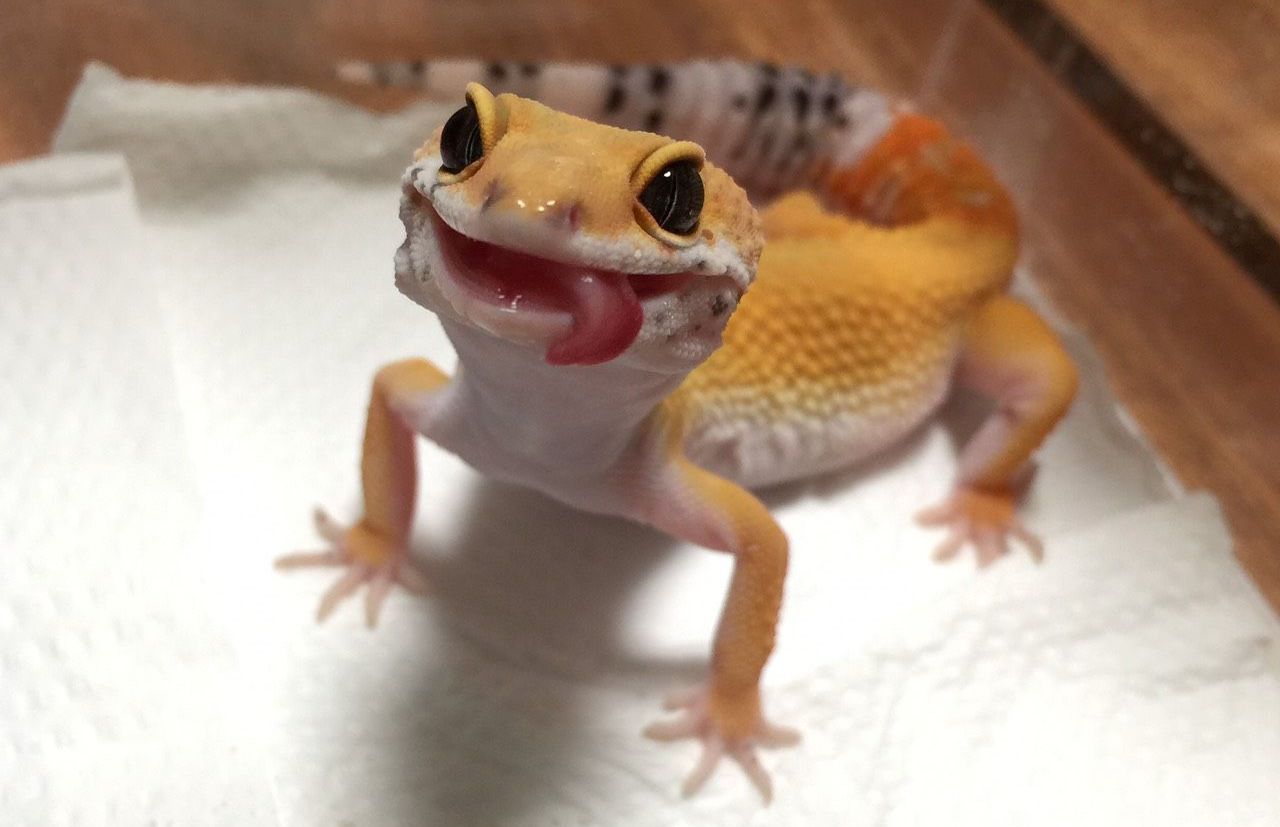
Why don't you and I have a little rest from quantum physics, materials science and chemistry on this beautiful Friday day? What do you think? After all, the world of scientific research, research and discovery is not limited to one direction. Physics, chemistry, biology, astronomy, etc. - every day we learn something new in these areas, and it would be wrong to limit our attention to you only with, say, physics. Therefore today there will be a little bit of biology. Studying various, both in the subject and in the direction, scientific publications, I came across a curious discovery. And since the main character of this discovery is a creature that I always liked, I could not pass by. So, the discovery says - ordinary geckos are able to run on water. Not very impressive? Do not rush to conclusions, because these small nimble lizards are used to make such movements, unlike other animals, several techniques at once. If you are still wondering how they do it, we will not linger. Go.
The main character of
Geckos is not one type of creature, but a whole family of more than 1,100 species, each of which has its own individual peculiarity, from the size and color to the habitat and diet. The appearance of geckos can be very unusual, but this is due to the habitat and habits of the species.

Leaf-tailed gecko
For example, this baby, hawk-tailed gecko, can easily hide among dry foliage. True, his appearance prompted the discoverers to give him not the sweetest name - satanic leaf-tailed gecko (satanic leaf-tailed gecko). In my mind, only one word arises from his mind - Drakaris. :)
It has all this motley (or it may be more correct to say dissonant) fraternity and common features, at least in many of the species. The most noticeable is their ability to depict Spider-Man, or rather, to cling to almost any surface and move not only vertically along the walls, but also along the ceiling. The most interesting is the principle by which they are able to do it - a lot of microscopic hairs cover the gecko's limbs. These hairs cling to the surface due to the strength of van der Waals. By the same principle, the aforementioned comic book hero clings to the surfaces.

On the left is a frame from the movie “Spiderman” (2002), and on the right is a macro photo of the pads on the gecko's foot.
Also, do not forget about the incredible eyes of geckos. Species, mainly active at night, have high photosensitivity. In other words, their eyes are able to capture even insignificant light radiation, which allows them to even recognize colors in the dark. Geckos' super vision has been repeatedly studied. For example, in this study, scientists describe the different properties of the eyes of two species of geckos: the daytime Phelsuma madagascariensis grandis (Madagascar giant day gecko) and the nighttime Tarentola chazaliae ( head- headed gecko).
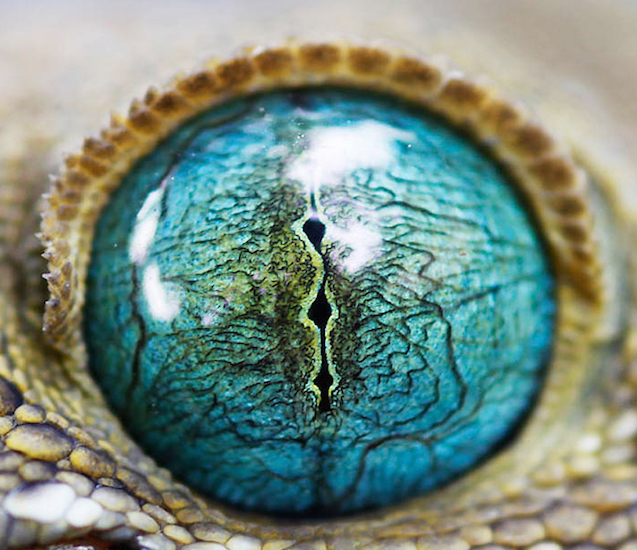
The appearance of the eye of Gekko smithii (large flattering gecko or Smith gecko).
But today we have gathered not to study the incredible visual abilities of geckos, but their equally incredible acrobatic skills. Therefore, we proceed directly to the study itself.
The essence of the study
In the tropical forest on the territory of Singapore, a high-speed video was made of how a small gecko overcomes a water obstacle to get to the tree.
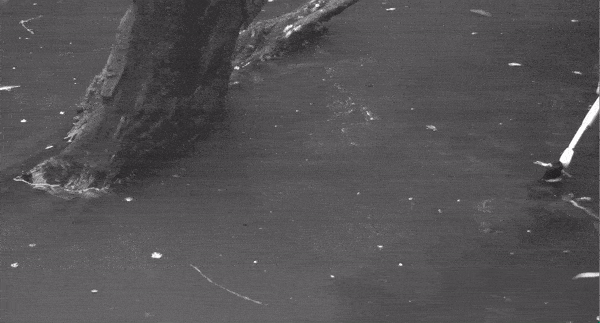
The speed of its movement was almost the same as when driving on a solid surface. This video posed a question for scientists - how do geckos do this? Laboratory studies were carried out, which showed that geckos use several techniques at once to move on the water surface, which makes them quite unique in the animal kingdom.

Waterman
Researchers note that evolution has given different animals that can navigate through water, different ways to achieve this. So, some small insects have a non-standard structure of the limbs, which allows them to stay on the water due to the force of surface tension. However, this method is not universal, because other animals of larger sizes have evolved differently. For example, a helmet-bearing basilisk can literally run on water. Rapid movements of the hind legs allow it to accelerate to 12 km / h and run about 400 meters.
Demonstration of running on the water in the performance of a helmet-bearing basilisk, which is not for nothing called Jesus Christ lizard.
Scientists share two main methods of moving animals through the water: movement due to surface tension and movement due to certain movements of the limbs.
In small creatures Bond number * <1, therefore, to ensure retention on the surface of the Weber number * should also be <1.
Bond number (Bo) * is the ratio of the force of gravity and the force of surface tension.
Weber number (We) * is the ratio of inertia of a fluid to surface tension.
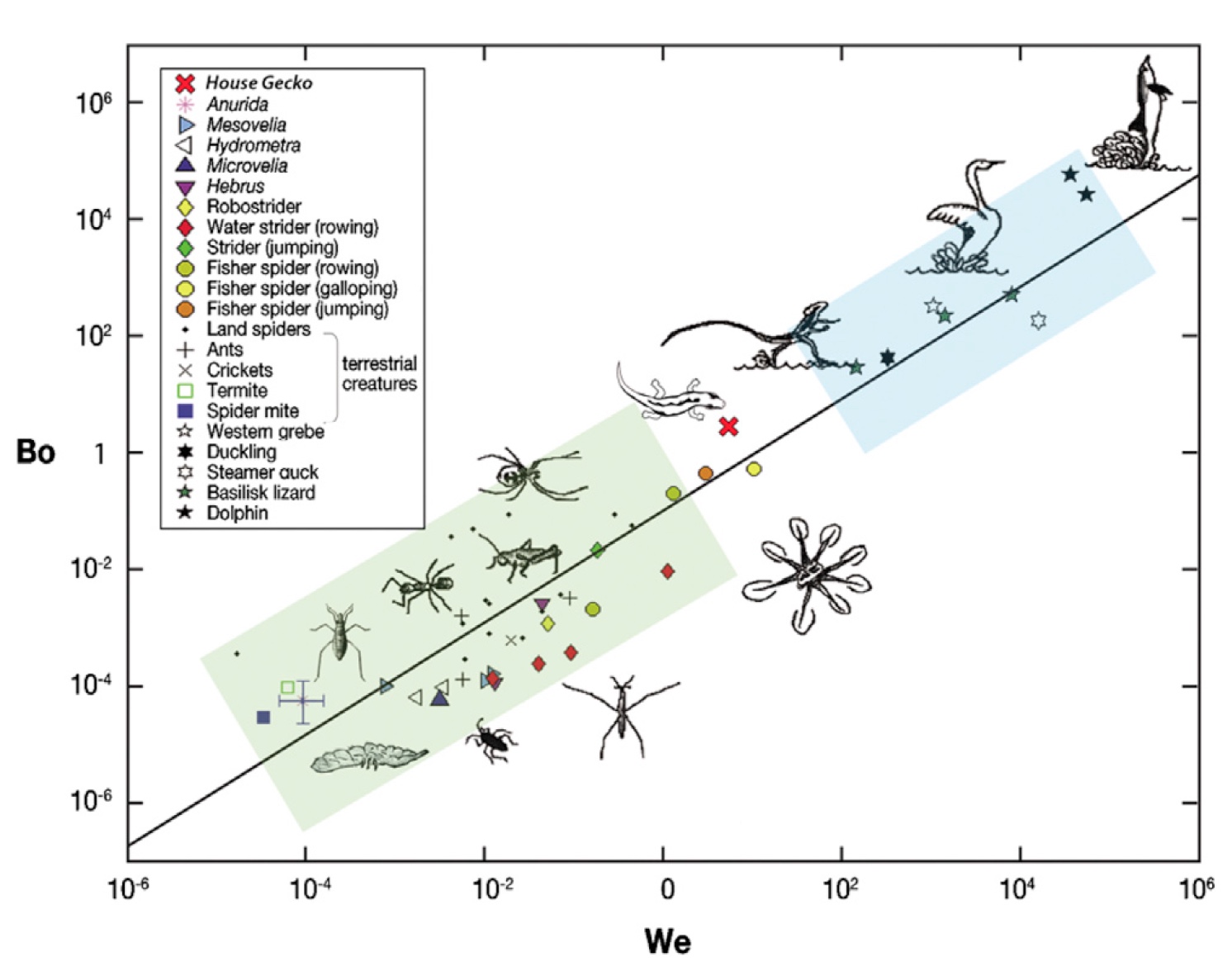
Graph of the ratio of the number of Bond and the number of Weber, as well as where the scale of various living organisms.
In large animals, the number of Bond and the number of Weber, of course, large, because they can not use the first method of movement on the water surface. Therefore, they must act in the opposite direction, that is, apply force on the surface of the water (slaps, strokes, flap, limbs, etc.).
The uniqueness of geckos lies in the fact that their Bond and Weber numbers (Bo = 8.7 ± 0.5, We = 47.4 ± 31.7) are located somewhere between the two main categories according to the method of movement, marked in green and blue on the graph above. Thus, scientists came up with the theory that geckos can use both surface tension force and limb movement at the same time to move through the water. And any theory requires proof (if it is not an axiom, of course).
"Gekkonova" kinematics
In the test took part 8 individuals. In total, there were 63 water races.
The scientists noted that, unlike the helmet-bearing basilisk, the gecko's body is not completely above the water. However, the gecko makes movements with its limbs in such a way that air cavities are formed between them and the water surface, as in the basilisks. The body position is as follows: the front half is above water (the average height of the head is above water is 13.4 ± 2.2 mm), the back half is in contact with water, the tail is immersed in water and is always parallel to the surface.
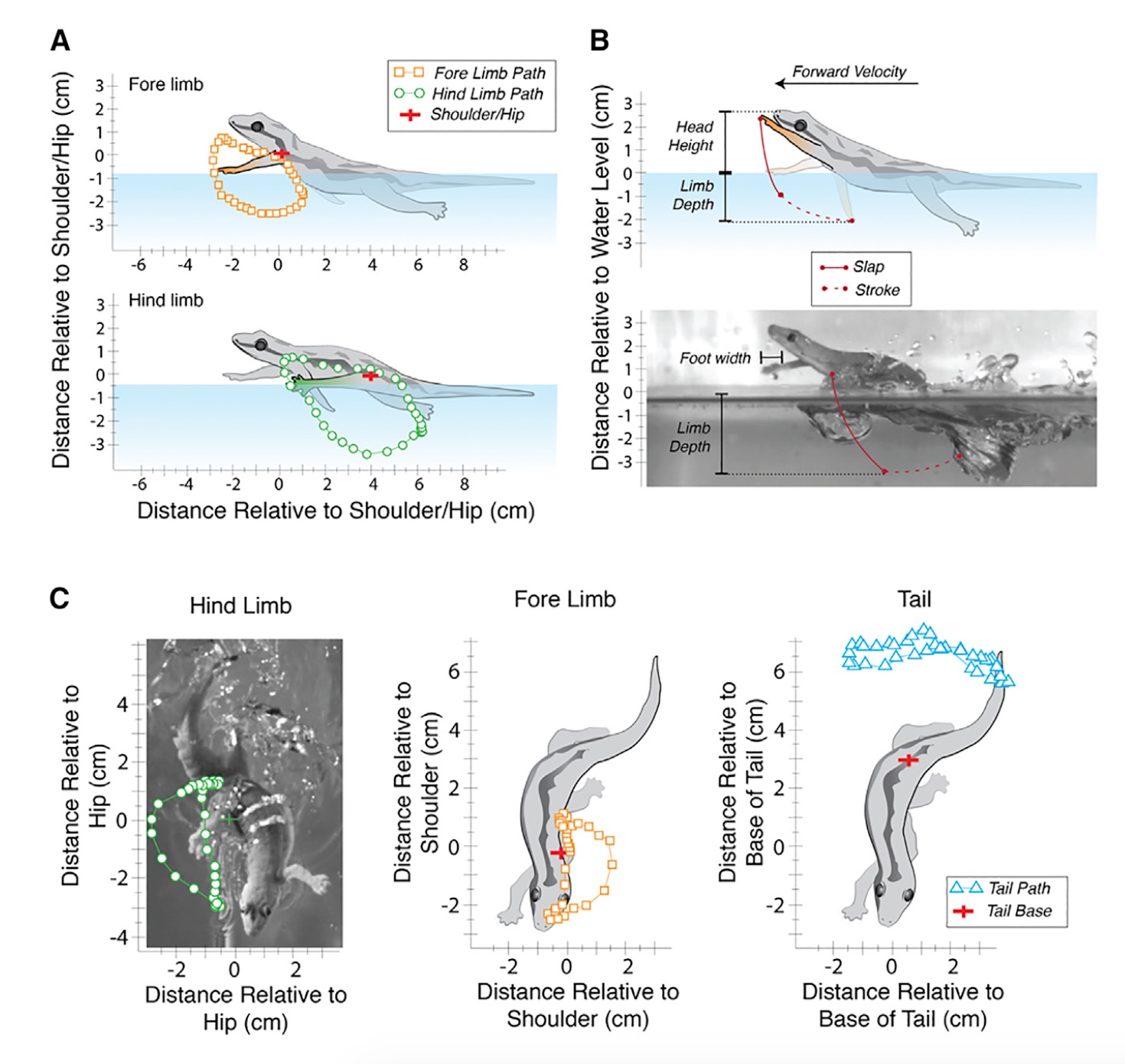
Schematic representation of the gecko's body position while moving along the water surface.
Water locomotion of a gecko is very similar to the one that it demonstrates when running on land, when the forelimb moves in phase with the opposite back (front left + rear right, etc.). This observation is also unusual, since reptiles are not touched by limbs during high-speed swimming.
Despite the partial immersion of the body under water, the gecko can move through the water at a speed of 60.7 ± 5.4 cm / s, which is approximately equal to 10.5 lengths of the gecko's body per second. This indicator practically does not change when driving on land. And the maximum water speed recorded during the tests was 97.5 cm / s (3.51 km / h).

The movement of the gecko on the water (side view).
When such speeds are reached, geckos are able to raise about 72% of their bodies above the water surface, which allows reducing the wave resistance.
Scientists also note that such movement of geckos by water cannot be described as swimming, which is confirmed by observations made.
As for the movements of the limbs, the similarity between the basilisk and the gecko is in fact, even though their bodies are located differently. Both "water runners" hit the paws on the water, creating an impetus that allows you to continue the movement (above image B). The most important element of such a movement are air cavities, which should be formed at the moment of impact on the surface of the water.
The most obvious difference, as mentioned earlier, is the position of the body between the gecko and the basilisk. Basiliski, when running in water, are straightened vertically, they use only the hind limbs to create impulses, and their body, respectively, is completely above the water. Geckos, on the other hand, cannot do so because of their short limbs and their inability to change their body position from horizontal to vertical.
What to do in this case? Use all 4 limbs, of course. What the gecko does is that the speed of each of them hits the water 76.2 ± 33.1 cm / s for the front and 91.5 ± 29.4 cm / s for the hind legs. As we can see, the speed of the hind limbs is significantly higher than the front ones, which is due to the almost horizontal position of the gecko's body.
Also worth noting is the difference in air cavities in geckos and in basilisks during strikes on water. In geckos, cavities are more oblong and widen caudally (that is, towards the tail). This leads scientists to the suggestion that such a form helps more in creating some kind of thrust than in raising the body above water (as in a basilisk).
Thus, it becomes clear that geckos cannot completely rely on shock movements of limbs, like basilisks, to overcome the path along the water surface. Therefore, this mechanism of movement is used by them in conjunction with others, and more precisely with surface tension.
Surface tension
Water striders can not just "stand" on the water, but also run calmly through it due to surface tension. Some small lizards can also stay on the surface of the water due to this phenomenon, but only in a stationary state. Researchers neatly placed the gecko in the water during testing. His body kept on the surface, even though most of it was immersed (do not worry, the gecko was placed in the water for a short while, then immediately removed). Therefore, it is obvious that water surface tension is not a 100% source of geckos' ability to run through water.
However, do not discard this phenomenon completely. To begin with, the researchers note that the skin of geckos is extremely hydrophobic (repels water), and this property can reduce drag (MDA, without physics), due to mechanisms based on a high degree of surface tension at the level of contact of this type of skin. with water.
To test this theory, a series of tests were carried out in water and in a soap solution (that is, in water with surfactants that reduce surface tension by 50%).
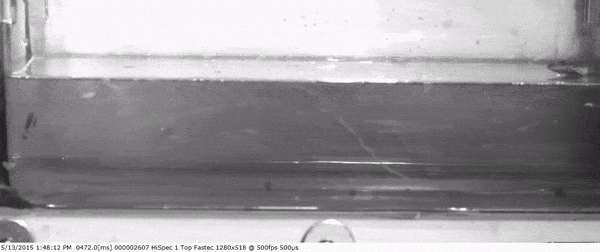
The movement of the gecko in a soapy solution (side view).
Basilisk in soap solution showed the same results as in plain water. This was predictable, since this animal does not use surface tension in the arsenal of mechanisms for running through water. But geckos were much more difficult. Their speed decreased by approximately 58%.
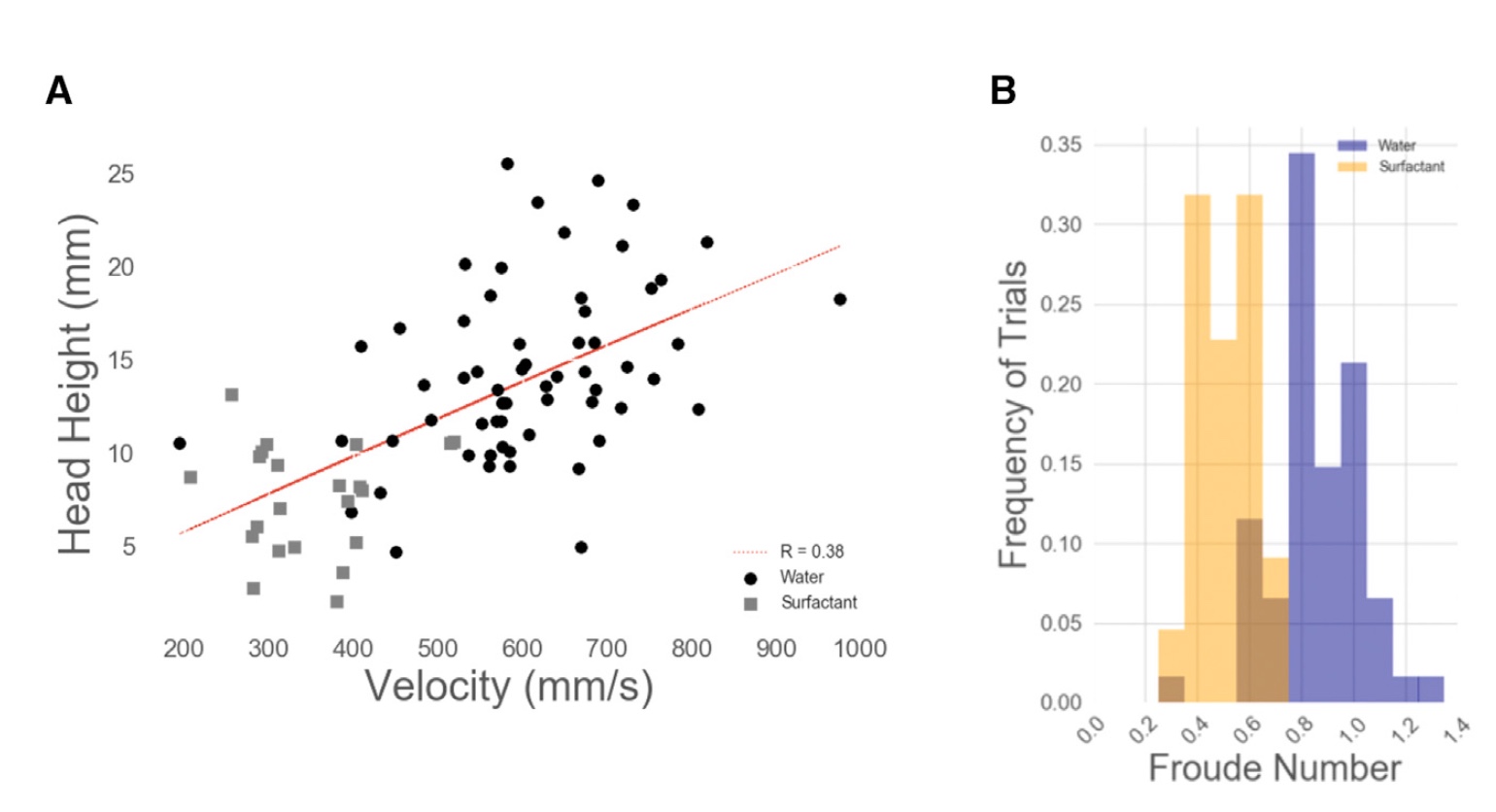
The effect of surface tension on gecko locomotion.
At the same time the speed of impulse shocks did not change. The period of stroke became a little longer. And the gecko's body was more immersed in soapy water than in water. The height of the head above the soap solution was lower by 49%, compared with the height above pure water.
Hydrodynamics and hydrostatics
It is known that animals whose Froude number (Fr, the criterion for the similarity of motion of liquids and gases) is 1.0 can move through the water due to aquaplaning, generating a hydrodynamic rise by moving the body with a positive tilt angle from side to side. When the Fr value fluctuates in the range of 0.6 ... 1.0, animals stay on the water due to both hydrodynamics and hydrostatics (in this case, buoyancy).
Scientists have noticed a positive correlation between the height of the head rising above the water and the speed of the gecko. Also, the body itself, or rather its form, fits perfectly into this theory. Common geckos have an impressive body tilt (bend) angle - 26.4 ± 9.4. Also, their body is dorsoventrally flattened, and the ratio of length to width is 3.7 ± 0.4. The abdominal surface is flat. Such a physiology can not help in such a difficult matter as water resistance.
However, these aspects of the researchers have not yet studied to the end, because they do not want to make loud statements.
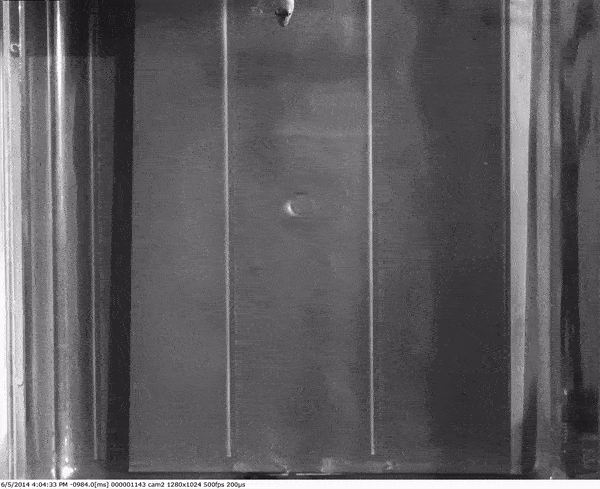
The movement of the gecko on the water (top view).
The movement of the gecko in a soapy solution (top view).
And, of course, geckos use their flexibility during movement, as seen in the animation and in the video above. Both in pure water and in a soapy solution, geckos retain the same amplitude and waviness of movements.
For more detailed acquaintance with the study, you can look at the link (report of the research group + additional materials to it).
Epilogue
This study may seem strange to someone, to put it mildly. Scientists gathered in the laboratory and began to run geckos on the water (a dream, not a job). However, such studies help to understand what previously remained either unnoticed or unexplained.
Geckos have not previously been classified as creatures capable of running in water. This study proved that they are on the list of their rightful place. In addition to this zoological justice, researchers also note the importance of their observations in robotics. A complete understanding of how animals navigate through water can help create robots that can repeat this trick. And considering that geckos use everything at once in their arsenal, unlike other aquatic dancers, their importance in this process is immeasurably great.
In addition, is it not surprising that a small but nimble lizard could surprise the learned world with its unusual and, at first glance, inexplicable skills. In my opinion, this only proves once again how little we know about the world and the creatures that surround us.
Do not forget about Friday offtop:
Video showing that not only cats and dogs can be excellent pets. And geckos can catch mosquitoes, which is good too :)
Thank you for your attention, stay curious, and have a good weekend, guys.
Video showing that not only cats and dogs can be excellent pets. And geckos can catch mosquitoes, which is good too :)
Thank you for your attention, stay curious, and have a good weekend, guys.
Thank you for staying with us. Do you like our articles? Want to see more interesting materials? Support us by placing an order or recommending to friends, 30% discount for Habr users on a unique analogue of the entry-level servers that we invented for you: The whole truth about VPS (KVM) E5-2650 v4 (6 Cores) 10GB DDR4 240GB SSD 1Gbps from $ 20 or how to share the server? (Options are available with RAID1 and RAID10, up to 24 cores and up to 40GB DDR4).
VPS (KVM) E5-2650 v4 (6 Cores) 10GB DDR4 240GB SSD 1Gbps until January 1 for free if you pay for a period of six months, you can order here .
Dell R730xd 2 times cheaper? Only we have 2 x Intel Dodeca-Core Xeon E5-2650v4 128GB DDR4 6x480GB SSD 1Gbps 100 TV from $ 249in the Netherlands and the USA! Read about How to build an infrastructure building. class c using servers Dell R730xd E5-2650 v4 worth 9000 euros for a penny?
